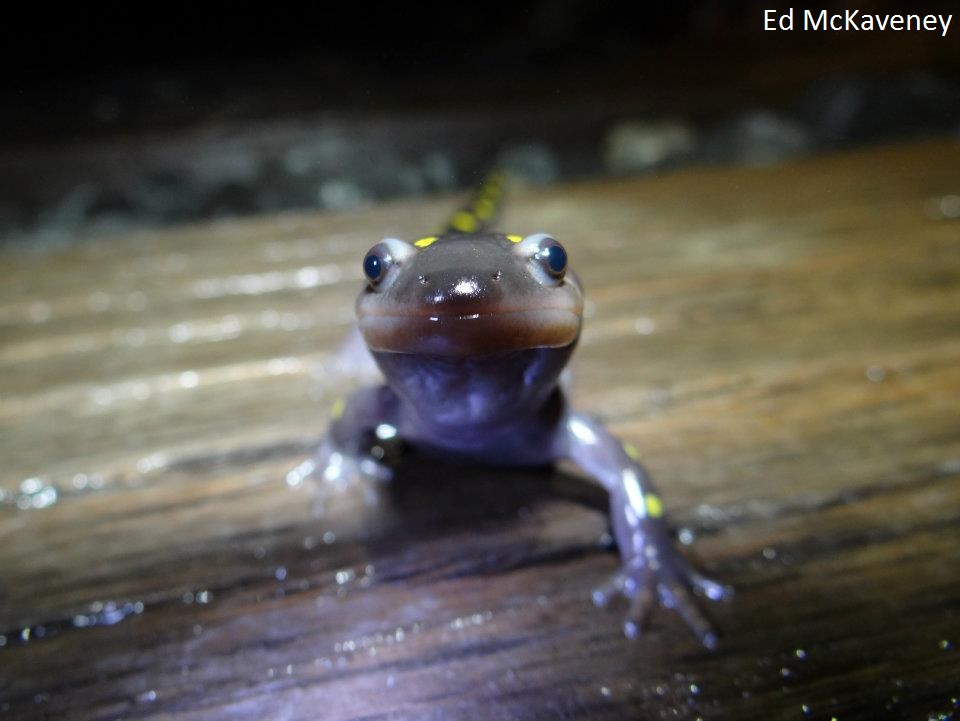Blog
_747_390_s_c1.jpg)
#bioPGH Blog: Salamanders in the Spring
 A resource of Biophilia: Pittsburgh, #bioPGH is a weekly blog and social media series that aims to encourage both children and adults to reconnect with nature and enjoy what each of our distinctive seasons has to offer.
A resource of Biophilia: Pittsburgh, #bioPGH is a weekly blog and social media series that aims to encourage both children and adults to reconnect with nature and enjoy what each of our distinctive seasons has to offer.
It was dark and rainy night in early March, just this past Tuesday actually, slightly chilly and spooky with the wind rustling through the trees, and the sound of falling raindrops was overpowered by the chorus of spring peepers. In the thrill of the ambience, a small group of determined researchers cautiously waded into a vernal pool—a shallow “pond” that was only present during the rainy spring and fall days. In the summer, it would be a muddy expanse, perhaps even completely dry; but for now, the pool was full of water, eager students and professors. This group was on the lookout for spotted salamanders.

Have you ever seen one of these elusive amphibians? Early spring nights are really the only chance for a glimpse. For most of the year, as a type of mole salamander, spotted salamanders live underground near a water source. Since the forest floor provides a veritable feast of invertebrates (insects, snails, worms and such), the salamanders have little reason to often go on treks aboveground. However, on the first “warm” rainy nights of spring, when the temperature is hovering around 50 degrees Fahrenheit, spotted salamanders come out in the open to spawn. Those evenings are exactly what had brought out our researchers earlier this week. Spotted salamanders were laying their egg masses in vernal pools, and no one wanted to miss either an egg mass or a salamander itself.
What was so important to these folks that they would trek into a cold rain in the middle of the night? The answer is simple: amphibians around the world are in decline. Like other amphibians, spotted salamanders have thin semi-permeable skin, which makes them susceptible to pollutants in their environment. This has designated them as “bioindicators,” an ecological canary in a coal mine. This means that if there is a problem in a given habitat, such as poor air or water quality or soil contamination, amphibians are often the first to show signs of decline or impact. Considering how important amphibians are, both as predators in their ecosystems and as bioindicators, it is vital that we understand their biology.
The two Duquesne University professors leading the night hike, Dr. Sarah Woodley and Dr. Brady Porter, have been monitoring a population of spotted salamanders north of Pittsburgh for years, and they have enthused generations of undergraduate and graduate students to continue the joy of searching for salamanders—even long after graduation. Though they have published some of the findings that have arisen from these evenings, what is perhaps more important is that they are calling attention to a secretive little amphibian, often overlooked simply because few of us know when and where to look. So just think: the next time you pass by a vernal pool, you are probably passing by a veritable nursery for amphibian eggs or even some little larval salamanders!
*Note, any work or study with animals should only ever be conducted by trained individuals who have gone through appropriate approval processes. Though we may love wildlife and crave to be near them, often the most caring thing we can do to protect animals is to stay away from them.
Connecting to the Outdoors Tip: If you would like to help monitoring amphibians, check out the Pennsylvania Amphibians and Reptiles Survey. They have resources for learning to identify and spot various salamanders and frogs, and you can even submit your observations to be included in the state record. Pennsylvania also has a state Wildlife Action Plan that encourages citizens to get involved in monitoring wildlife and look for ways to support restoration. Learn a bit about the plan, and then check out Chapter 4, which is all about the ways we as citizens can get involved!
Continue the Conversation: Share your nature discoveries with our community by posting to Twitter and Instagram with hashtag #bioPGH, and R.S.V.P. to attend our next Biophilia: Pittsburgh meeting.
Resources:
National Wildlife Federation: Spotted Salamanders
US Fish and Wildlife Service - Amphibians in Decline
Woodley, S. K., and B. A. Porter, Journal of Zoology, 2015.
Photo Credit: Andreas Weith CC-BY-SA-4.0, Greg Schechter CC-BY-2.0, and Ed McKaveney

